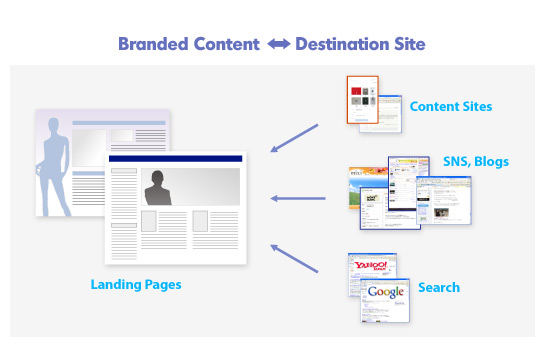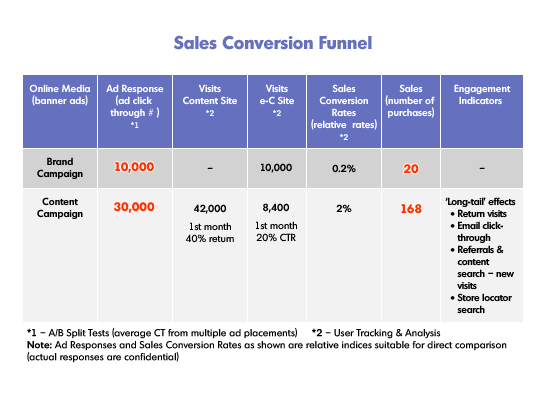
Keywords
branded content
customer engagement
marketing ROI
performance metrics
social marketing
July 16, 2010
Effectiveness of Engagement Marketing for Increasing Online Sales Conversion: Branded Content ROI for a Luxury Brand
A well-known international luxury products brand required a promotion program to introduce its new eCommerce site. The company's competitive brief called for a 'brand campaign' to generate traffic for the Japan eCommerce site, with the ultimate success metric being sales conversion. The campaign was to be primarily digital marketing with a minimal offline presence to maintain an integrated marketing message.
The challenge was that the brand's primary customer segment (as well as main product categories) was not the campaign target. Consequently, the 'brand campaign' proposal focused on a relationship marketing approach designed to capture attention and build an emotional attachment with an essentially new audience. In addition, the proposal featured a rigorous performance management approach to optimize the marketing execution and to validate the return on investment (ROI).
Branded Content and Customer Engagement
The promotion program was based on a mix of content, community and product to first engage customers and then to promote sales. In particular, distinctive content associated with the brand ('branded content') was expected to be highly effective in attracting customer interest and in helping to create a personal attachment and engagement with the brand.
The core of the program was an online magazine developed to create and strengthen the connections between the target customer segment and the brand. The editorial and video content focused on aspects of the customers' lifestyles consistent with the brand values and aimed to extend the brand association to various related communities of interest.
While the program encompassed multi-channel components, online was the essential element for establishing brand engagement. The magazine content was essential for building customer interest and also for providing a media platform for promoting online sales. In this regard, the branded content was leveraging how consumers seek and interact with digital media.
The Customer Journey
Custom developed content was the basis for attracting and aggregating potential customers. Initial traffic was attracted through online advertising supported by offline/online promotion. Sustaining traffic developed through repeat visits, social media, referral links from communities of interest (COI), and natural search.

Referral links and search results related to various COI produced as much as 60% of the sustaining traffic flow. This result particularly highlights the social marketing aspect of the communications plan. The brand was introduced to consumers by being relevant to their interests, and the association with those communities of interests served to promote an enduring relationship.
The online magazine offered a natural media format for brand/product marketing. The expectation was that contextual advertising (i.e., luxury product in a relevant lifestyle environment) would be highly effective. Over the course of the program, the peak contextual advertising result was an advertorial-based product promotion where about 50% of the visitors who viewed the product content clicked through to the e-Commerce site. The core of the consumer response was based the content context and brand associations, with reinforcement from multiple exposures per visit and repeat visits.
Performance Management
The program was accountable for very specific e-Commerce traffic and sales objectives. Consequently, there was extensive focus on key performance indicators, with on-going evaluation and optimization of virtually all aspects of the online execution. In this regard, the program was leveraging the measurability of web activities and the ability to validate results.
A substantial part of the campaign budget was devoted to online advertising to create the initial customer base; and ads for various media placements were subjected to A/B or multivariate split testing (random presentation of alternative ads) and a continuous improvement process. The process encompassed creative execution and different types of advertising.
In particular, there was an extended comparison of branded content advertising vs. a more traditional online brand campaign. The intent was to provide a baseline for advertising effectiveness and to validate the incremental effectiveness of the engagement approach based on branded content.
User tracking and analysis focused on the magazine site's effectiveness for quality visits and encouraging repeat visitors. And most critically, the magazine's value as a media platform that generated click-through to the e-Commerce site was a key focus area.
Finally, referral traffic to the e-Commerce site was monitored to determine sales conversion effectiveness. The engagement program referral traffic was benchmarked against direct product advertising to establish the relative marketing ROI.
Branded Content ROI
The engagement program ran for 6 months, and key results are summarized in the sales conversion funnel table below. The campaign results strongly indicate the overall effectiveness of online engagement marketing:
-
Attracting visitors: content ad response 3X greater
- - Content ads consistently tested 2-4 times more effective than comparable brand campaign ads for attracting visitors (see Ad Response in the table below);
- - The brand campaign execution used for comparison had been optimized and improved 35% and generally performed at least on par with the advertising agency click-through rate (CTR) projections - which indicates that the content ads were not only better, but exceptionally effective and cost efficient.
-
Activating sales: branded content sales conversion 8X greater
- - Building brand engagement results in a much higher sales conversion (see Sales in the table below);
- - The quality and relevance of the branded content media provides a context for effective brand/product advertising.

Online advertising accounted for approximately 40-50% of the total campaign budget with the balance devoted to custom content development. Based on this ratio, the overall marketing ROI of this content-based program projects to about 3-4 times greater than the more traditional 'brand campaign' advertising approach.
To facilitate direct comparison of the two types of campaigns, the timeframe in this analysis is short-term (i.e., within 1 month). While these results show the content-based campaign as dramatically more effective, they also substantially understate the overall effectiveness of the engagement program.
The longer-term branded content impact, listed as 'long-tail' effects in the sales conversion funnel table, is not included in this analysis. After the initial flights of advertising, the magazine enjoyed a stable and growing audience. The longer-term return visitors and the new visitors from an ever-increasing COI referral network added a sizable long-tail to the campaign investments. Moreover, the proportion of visitors clicking through to the eCommerce site or searching the store locator increased along with the return visitor rate, indicating that a longer-term comparison would be even more impressively one-sided.
Summary
As advertising budgets shift toward digital marketing, measurability and marketing ROI becomes an increasing focus for most companies. In this case study, performance management provided real-time feedback and continuous improvement through the entire consumer journey from initial advertising exposure to sales conversion. In the final result, the overall marketing ROI validates the relationship marketing approach, even for a fairly short-term promotion campaign.
Finally, these findings support the general trend toward increasing online budgets for custom content development and publication. The mix of content, community and product clearly increases the overall marketing ROI. While the nature of content and community will change depending on the brand and the marketing objectives, custom branded media can promote brand engagement and, in turn, produce very substantial increases in sales conversion.
For further information, please contact